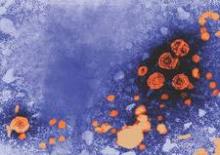WASHINGTON – Reactivation of tuberculosis and hepatitis B infections after starting treatment with anti–tumor necrosis factor therapy was “rare” in a large national cohort study of veterans with inflammatory bowel disease, Dr. Jason Hou reported at the annual Digestive Disease Week.
The estimated rate of tuberculosis reactivations was 2.8 per 10,000 patient-years of exposure to anti-TNF therapy “in a fairly well-screened cohort of IBD patients,” said Dr. Hou, codirector of the Inflammatory Bowel Disease Center at Baylor College of Medicine, Houston. The estimate for HBV reactivation or acute liver failure in this cohort was less than 1.4 per 10,000 patient-years of exposure, he noted.
Practice guidelines recommend that patients with IBD should be screened for latent tuberculosis and HBV before starting treatment with an anti-TNF drug, but how often reactivation actually occurs in this population is not known, he pointed out. Moreover, recent studies have questioned the cost-effectiveness of universal screening for HBV before starting treatment, and TB reactivation rates in patients with IBD treated with anti-TNF drugs “have not been assessed on a national population level.”
Dr. Hou and his associates used a national Veterans Affairs database to identify patients who had been diagnosed between 2003 and 2011 with Crohn’s disease or ulcerative colitis, based on ICD-9 codes, and had filled at least one prescription for infliximab, adalimumab, or certolizumab pegol; they also looked for codes related to possible tuberculosis reactivation or acute liver failure related to HBV reactivation at the time of or after anti-TNF therapy was started. Cases were then verified by reviewing electronic medical records of patients to confirm the diagnosis of tuberculosis or HBV, exposure to an anti-TNF drug, and completion of pretreatment screening.
They identified 3,357 patients with IBD who had received a prescription for an anti-TNF treatment, representing 7,210 patient-years of anti-TNF treatment; most were men and were white. The mean time on treatment was about 2 years, and they had started treatment at a mean age of 57 years. Screening rates for tuberculosis were relatively high and remained stable throughout the study period, at 72% overall, but HBV screening rates were low, at 24% overall. HBV screening was not included in practice guidelines until 2006, and the rate significantly increased from under 10% at the beginning of the period studied to 42% at the end, Dr. Hou noted.
They identified 23 patients with ICD-9 codes related to tuberculosis occurring after they started anti-TNF therapy, but “on chart review, only two patients were confirmed to have tuberculosis reactivation” related to anti-TNF therapy, which occurred at 8 and 18 months of treatment, he said. “Very interestingly, both of these patients had latent tuberculosis and documented completed courses of INH [isonicotinylhydrazine] and a negative chest x-ray prior to [anti-]TNF initiation.” Because the only cases of tuberculosis reactivation occurred in patients with a prior history of latent tuberculosis, “we should maintain extra diligence in those patients even if appropriate screening has been performed,” he advised.
They identified 12 patients with codes related to hepatitis B after the treatment started, two had clinically relevant outcomes, but the chart review indicated that neither case was HPV reactivation. There were two cases of patients with positive HBV tests. One of these patients, who developed acute jaundice with serologies consistent with acute HBV infection, reported a possible exposure to HBV and was newly diagnosed with HIV, associated with the same encounter. This patient was on infliximab and continued treatment, and HBV viremia spontaneously cleared without antiviral treatment, Dr. Hou said.
The second “clinically relevant” case was a patient with chronic HBV infection, identified in a presurgical screen, who was asymptomatic and had normal liver function tests. Infliximab was discontinued and the patient started antiviral therapy; viremia resolved and the patient resumed treatment with infliximab “without complications,” Dr. Hou said.
Another four patients were identified related to codes for acute liver failure, but on chart review, none had liver failure related to hepatitis B.
The study’s limitations include the possibility that patients may receive medical care outside the VA system, which would not be picked up in the analysis, he said, but added, “when we look at our estimate of tuberculosis reactivation, they mirror almost exactly those reported in the rheumatology literature in screened populations.” Another limitation is that the study depended on the accuracy of ICD-9 codes for the diagnoses, but all outcomes were verified in the chart review, he said.
Dr. Hou is also director of Inflammatory Bowel Diseases and an investigator in the clinical epidemiology and outcomes program in the Center for Innovations in Quality Effectiveness and Safety at the Michael E. DeBakey VA Medical Center, Houston.

